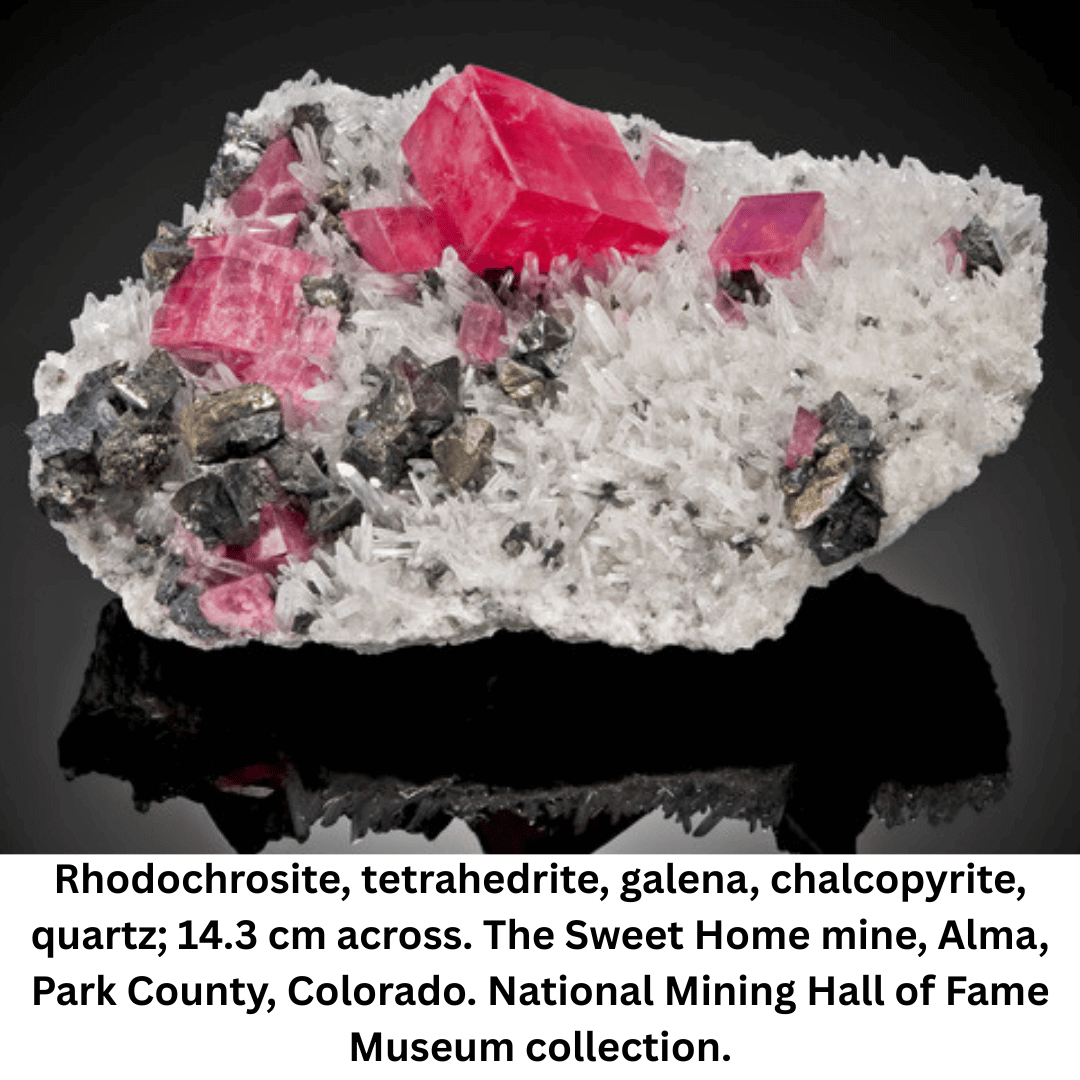Colorado isn’t just famous for its natural beauty above the ground; it’s also rich with gemstones, minerals, and fossils to be discovered. According to the Colorado Geological Survey, more than 30 varieties of gemstones are found in the Centennial State. Aquamarine, rhodochrosite, and fossilized dinosaur bones are just a few of the Colorado gemstones (and gembones) that appeal to lapidary artists and jewelry aficionados alike. You’ll find all these and more on your Denver gem show adventure.
Whether you’re drawn to the icy blues of aquamarine, the dramatic reds of rhodochrosite, or the earthy, intricate patterns of fossilized dinosaur bone, these gems of Colorado offer a unique way to appreciate nature’s beauty. This remarkable intersection of natural art, time, and skill allows gem lovers to display, collect, and wear gemstones from the Rockies.
Colorado State Gem: Aquamarine

Prospectors first discovered aquamarine in Colorado in the late 1800s while searching for precious metals during the mining boom of that era. The official state gemstone of Colorado, aquamarine is prized for its scarcity and color. You lucky March babies have aquamarine as your birthstone — a gem that reflects a peaceful, blue-sky attitude.
Colorado aquamarine is renowned for its origin in the high-altitude regions of the Rocky Mountains, particularly Mount Antero and Mount White. These gems are typically natural and untreated, which makes them especially appealing to collectors and jewelry enthusiasts who value ethically and naturally sourced gemstones. This differentiates Colorado aquamarine from many aquamarines on the global market that are heat-treated to enhance the color.
Jewelry designer Kristen Baird says, “Lots of people set aquamarines in silver jewelry, but I love them in 18K gold as well.” Aquamarine’s blue tones remind Kristen of a perfectly clear summer sky that stretches to the horizon. She confesses, “I could honestly gaze at it all day long!" Gold’s warm glow pairs harmoniously with aquamarine’s cool blue, making the gem appear even more vibrant and luminous. Many people wear aquamarine as a talisman for inner peace.
Colorado State Mineral: Rhodochrosite
While aquamarine provides a serene blue hue, rhodochrosite dazzles with its luscious red color. Rhodochrosite is a manganese carbonate mineral found in a range of shades, including an intense red color ranging from light pink to cherry red. Nicknamed the “Inca Rose,” rhodochrosite is believed to symbolize love and life. It’s commonly used in carvings, beads, and decorative elements.
 Although rhodochrosite is found in several countries, The Sweet Home mine near Alma, Colorado, is legendary for producing large, high-quality crystals that are among the world’s finest specimens. These highly sought-after gems are exhibited in museums worldwide. Many people are familiar with banded pink-and-white rhodochrosite from Argentina, but Colorado rhodochrosite is dramatically different. Its transparent, gemmy crystals rival rubies with their clarity and luster.
Although rhodochrosite is found in several countries, The Sweet Home mine near Alma, Colorado, is legendary for producing large, high-quality crystals that are among the world’s finest specimens. These highly sought-after gems are exhibited in museums worldwide. Many people are familiar with banded pink-and-white rhodochrosite from Argentina, but Colorado rhodochrosite is dramatically different. Its transparent, gemmy crystals rival rubies with their clarity and luster.
John Cornish is an avid adventurer who has traveled the world collecting minerals and fossils. He is fascinated by Colorado’s geology and says, “The list of mineable species is impressive to say the least. Among those minerals recovered, both as by-products from metals mining and from stand-alone ‘specimen’ producing mines, Colorado yields an exciting palette of desirable treasures!” The Colorado state mineral holds a special place in John’s heart.
The gorgeous, red gem seems to glow from within. He admits that the “brilliant, super-saturated, bright cherry-red color” just makes him happy every time he sees it! When light enters these transparent to translucent crystals, it reflects internally, giving the appearance of an inner glow. If you’re using rhodochrosite crystals in jewelry, John advises protecting them in the proper settings because it is a relatively soft mineral that requires careful handling.
Colorado State Fossil: Stegosaurus
You may have encountered dinosaur bone without even realizing it! When dinosaur bone becomes fossilized over millions of years, its organic structure is replaced by minerals like agate, jasper, or quartz, creating a hard, durable material nicknamed “gembone.” When cut and polished, it reveals intricate patterns and earthy colors, making it popular among collectors who appreciate its natural beauty and historical significance.
Fossilized dinosaur bones from Colorado are typically from the Morrison Formation, a world-famous deposit that spans over 1 million square miles in the western United States. Although Colorado’s official state fossil is the Stegosaurus, most fossilized bone fragments can’t be linked to a specific species. Still, fossilized dinosaur bone is an inspiring material that offers a unique element for creating jewelry, knife handles, and more.
The unique structure and durability of fossilized dinosaur bone make it a distinctive choice in lapidary work. Artists and jewelers often craft it into cabochons, beads, and inlays, creating pieces that unite natural history with artistic expression. Shades of deep red, brown, gray, and even blue or green appear depending on the minerals that replaced the bone, giving every cabochon, bead, or inlay its own character. Fossilized dinosaur bone is associated with grounding energy and a connection to history.
Other Gem Treasures of Colorado
Beyond its official state gemstone and mineral, Colorado offers an incredible variety of collectible stones, including many birthstones. Although some of these stones are very rarely discovered in the Rockies, they belong to a group of over 30 different gemstones that can be found in Colorado.
Garnet: Deep red to reddish brown, these January birthstones are relatively abundant. Rockhounds find them in stream gravels. Mohs hardness 6.5-7.5.
Amethyst: This lavender to deep purple February birthstone is a rare find that collectors and jewelry artists especially prize. Mohs hardness 7.
Emerald: Found in small quantities in Colorado, these rich green May birthstones reflect the beauty of the mountain forest. Mohs hardness 7.5-8.
Opal: The milky white October birthstone is frequently found in volcanic rock formations. Mohs hardness 5.5-6.5.
Topaz: Historically found at Pikes Peak, this clear, golden, or light blue gemstone is the birthstone for the month of November. Mohs hardness 8.
Turquoise: The blue/green December birthstone with a distinctive matrix is found primarily in southwestern Colorado. Mohs hardness 5-6.
Discover Colorado Gems
Colorado is home to a captivating variety of gemstones, including those highlighted here, as well as citrine, fluorite, lapis lazuli, peridot, pyrite, rose quartz, selenite, and many others. From the cool blues of aquamarine to the brilliant reds of rhodochrosite and the timeless allure of fossilized dinosaur gembone, these natural treasures inspire collectors, jewelry makers, and gem lovers alike. Enjoy these dazzling works of history and nature’s artistry at the 2025 Denver Gem & Mineral Showcase! Every find is an adventure, promising the excitement of discovering nature’s rare and alluring treasures in the Rockies.
 Katie Hacker is a jewelry designer, author, and lifelong maker who loves the beauty of stones and gems. A former editor of the Tucson Show Guide and host of PBS’s Beads, Baubles & Jewels, she’s passionate about inspiring makers of all levels. Katie enjoys treasure hunting at gem shows and writing articles filled with insider tips and creative ideas to help readers discover their own spark.
Katie Hacker is a jewelry designer, author, and lifelong maker who loves the beauty of stones and gems. A former editor of the Tucson Show Guide and host of PBS’s Beads, Baubles & Jewels, she’s passionate about inspiring makers of all levels. Katie enjoys treasure hunting at gem shows and writing articles filled with insider tips and creative ideas to help readers discover their own spark.
Photo credits:
Fossilized dinosaur bone cuff by Jeff Fulkerson. Photo credit: Steven Llorca.
Primrose ring in 18K yellow gold and natural aquamarine. Photo credit: Kristen Baird, www.kristenbaird.com.
Rhodochrosite, tetrahedrite, galena, chalcopyrite, quartz; 14.3 cm across. The Sweet Home mine, Alma, Park County, Colorado. National Mining Hall of Fame Museum collection. Photo credit: Mark Mauthner.




